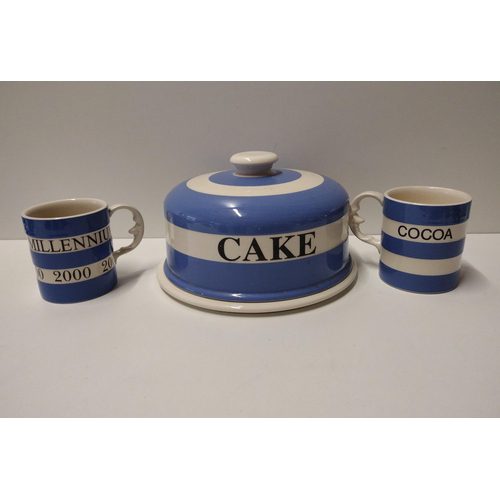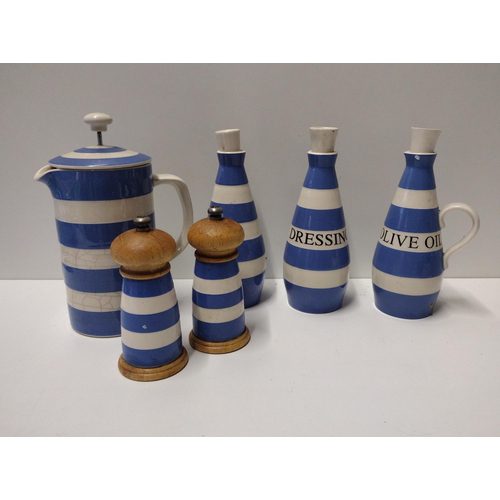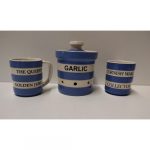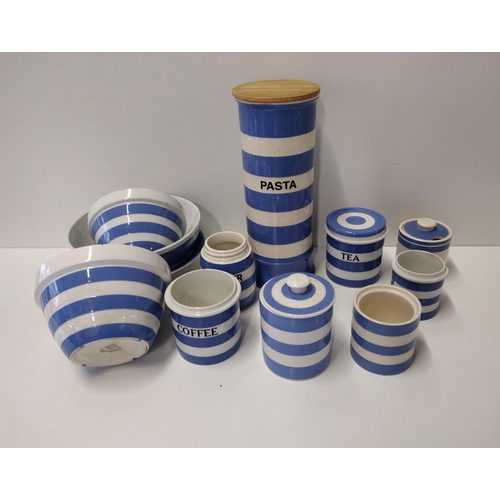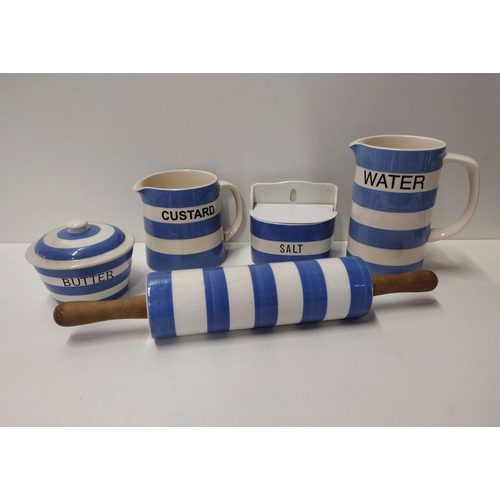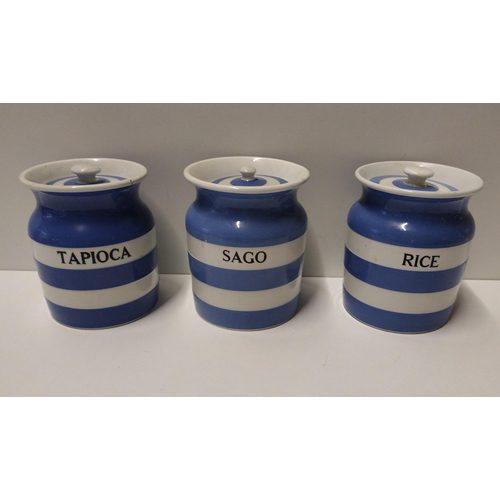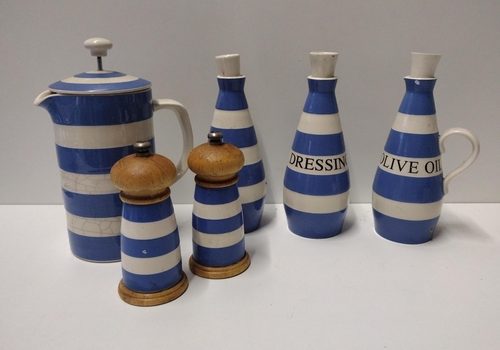
Unraveling the Elegance:
T.G. Green Cornishware, with its distinctive blue and white stripes, has transcended its utilitarian origins to become an enduring collector’s item. This iconic pottery, produced by the T.G. Green & Co. since the 1920s, captivates enthusiasts with its timeless design, historical significance, and the craftsmanship inherent in each piece. In this guide, we will explore the intrinsic value of Cornishware, the art of dating backstamps, the geographical evolution of T.G. Green’s production, and essential tips for maintaining the luster of your collection through proper cleaning.
Is Cornishware Valuable?
The value of T.G. Green Cornishware extends beyond its functional use to embody a nostalgic charm and historical significance. Originally designed for everyday use, the enduring appeal of Cornishware has transformed it into a sought-after collectable. The value of these pieces is influenced by various factors.
Rarity and Discontinuation
One key determinant of value is the rarity of a particular item. Early pieces from the 1920s, featuring simple ‘T.G. Green & Co.’ backstamps, are often more valuable due to their scarcity. Additionally, discontinued patterns and shapes contribute to the rarity of certain pieces, making them highly sought after by collectors.
Historical Significance
The history of T.G. Green & Co. and the evolution of Cornishware over the decades contribute to its value. Collectors appreciate the connection to a bygone era and the craftsmanship embedded in each piece. The enduring popularity of Cornishware ensures a steady demand in the collector’s market, further enhancing its value.
Quality of Craftsmanship
T.G. Green is renowned for its high-quality craftsmanship. Each piece is carefully crafted, and the hand-painted stripes add a personal touch. The durability of the pottery, combined with the timeless design, makes it not only a collector’s item but also a functional and enduring piece of kitchenware.
In essence, while Cornishware certainly holds monetary value, its true worth lies in the appreciation of its design, history, and the skilled craftsmanship that has made it a beloved collectable for generations.
How Do You Date Backstamps?
Dating T.G. Green Cornishware involves decoding the backstamps on each piece, providing valuable insights into its production timeline. Over the years, T.G. Green & Co. used various backstamps, and changes to these markings can help determine the approximate age of a piece.
Early Backstamps (1920s)
Early pieces from the 1920s may feature a straightforward ‘T.G. Green & Co.’ stamp. These early stamps are relatively simple, reflecting the early days of production and the simplicity of design.
Additional Details and Changes
As time progressed, T.G. Green & Co. introduced additional details to the backstamps. These may include phrases like ‘Made in England’ or specific pattern numbers. Collectors often consult reference guides and online resources to decode these backstamps, allowing them to trace the evolution of Cornishware over the years.
Reference Guides and Online Resources
For collectors, investing in reference guides or utilizing online resources dedicated to T.G. Green Cornishware backstamps is essential. These guides provide detailed information on the various markings used by the pottery, enabling collectors to accurately date their pieces and gain a deeper understanding of the historical context behind each one.
In summary, dating backstamps is a fascinating detective work that allows collectors to place their pieces within a historical timeline, adding an extra layer of appreciation to their collection.
Where is TG Green Cornishware Made?
The geographical origin of T.G. Green Cornishware is intertwined with the brand’s history. Understanding where your Cornishware was made provides valuable insights into its provenance and adds another dimension to the collector’s experience.
Church Gresley, Derbyshire (1920s)
The journey begins in Church Gresley, Derbyshire, where the T.G. Green & Co. pottery factory was established in the 1920s. The early production of Cornishware, with its classic blue and white stripes, originated from this location, marking the initial phase of the brand’s legacy.
Bridgwater, Somerset (1960s Onwards)
In the 1960s, T.G. Green & Co. underwent changes in its manufacturing locations, relocating its production to Bridgwater, Somerset. This shift in production marked a new chapter for Cornishware. Collectors may come across pieces with backstamps indicating either Church Gresley or Bridgwater, signifying the transition in manufacturing.
Provenance and Historical Context
The distinction between pieces made in Church Gresley and Bridgwater adds a layer of historical context to each collection. Some collectors may specifically seek pieces from the early Church Gresley period, appreciating the historical significance of these early productions.
In essence, knowing where T.G. Green Cornishware was made allows collectors to connect with the geographical evolution of the brand, providing a deeper understanding of the pottery’s history.
How Do You Clean Cornishware?
Preserving the beauty and integrity of your pieces is essential for collectors. Cleaning these pieces requires a delicate approach to avoid damaging the hand-painted stripes or the glaze.
Hand Wash with Mild Soap
To maintain the luster of Cornishware, it is advisable to hand wash each piece using mild dish soap and warm water. This method ensures a gentle cleaning process without subjecting the pottery to the harsh conditions of a dishwasher.
Avoid Abrasive Materials
Steer clear of abrasive scouring pads and harsh cleaning agents, as they can potentially damage the delicate surface of the pottery. Longevity is attributed to its durable glaze, and abrasive materials can compromise this protective layer.
Gentle Scrubbing for Stubborn Stains
For stubborn stains, a soft sponge or cloth can be used for gentle scrubbing. It’s crucial not to apply excessive pressure, especially on the hand-painted design, to prevent any potential damage.
Avoid using a dishwasher
The high temperatures combined with strong detergents in dishwashers can be detrimental to the quality of the pottery.
By following these cleaning tips, collectors can ensure that their collection remains in pristine condition, preserving its beauty for future generations.
Conclusion
Collecting T.G. Green Cornishware is a journey through time, craftsmanship, and the enduring appeal of a classic design. Understanding the value, dating backstamps, exploring the geographical evolution of production, and adopting proper cleaning practices contribute to a richer and more fulfilling collecting experience. Each piece of Cornishware becomes not just a functional item but a cherished artifact, connecting collectors to a legacy of craftsmanship and tradition that spans generations. As you embark on your Cornishware collecting journey, savor the stories embedded in each stripe and the history encapsulated in every backstamp, for it is in these details that the true magic of collecting T.G. Green Cornishware unfolds. Click here to view and bid on selected Cornishware pieces in our upcoming auction.
